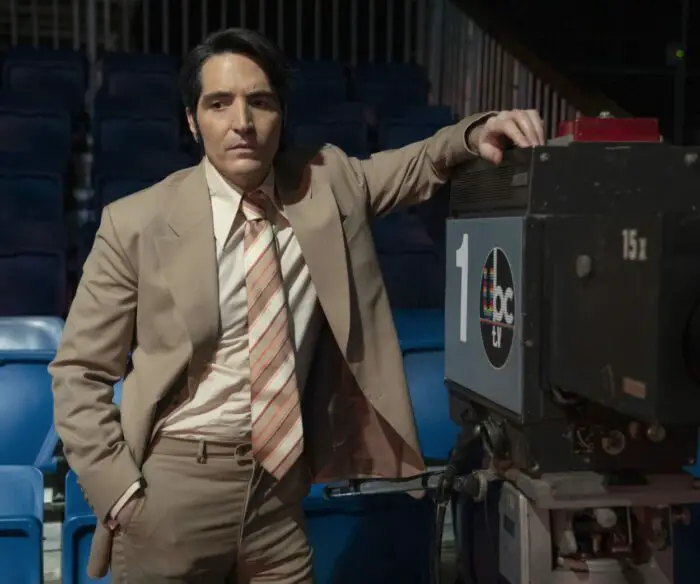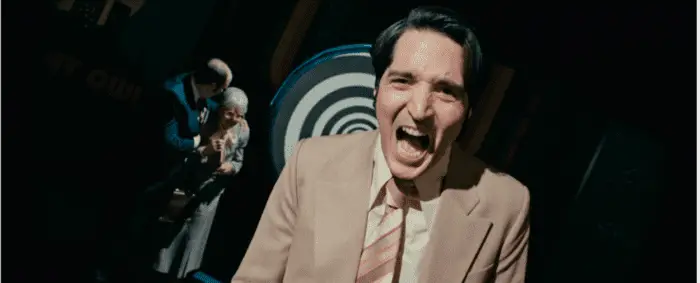Found footage as a genre often errs on the side of gimmicky. There’s only so much shaky cam an audience can handle, but Late Night with the Devil finds a way to dance around the confines of the style. The film introduces the audience to Jack Delroy (David Dastmalchian of The Suicide Squad), a Chicago radio host who has been given a chance to break into the coveted world of late-night television. It’s the 1970s and the United States is in social turmoil. Jack’s show, Night Owls, becomes a soothing balm of positivity, but it never reaches the heights of Johnny Carson. After the brief rundown of the rise of Jack and his show, the narrator explains that what the audience is about to see is the recently uncovered tape of the Night Owls live show from Halloween 1977. It’s behind-the-scenes footage that has never been seen before. The events of this broadcast shook the nation to its core, and it’s time for a new audience to experience the final Night Owls show.
In the 1980s, the United States was gripped with Satanic Panic. The decade saw chaos surrounding the alleged occurrences of Satanic ritual abuse. Some point to movies like Rosemary’s Baby (1968), The Exorcist (1973), and The Omen (1976) as potential causes for the widespread panic. Others point to the new religious movements and the Manson murders of the ’70s as other possible origins. Late Night with the Devil isn’t without its own shadowy, cult-like organization. Jack belongs to a group called The Grove that is highly selective and only open to elite men. Rumors have spread about orgies, sacrifices, and Satanic rituals, but members of The Grove insist that it’s simply a networking opportunity.

The found-footage angle is an especially intriguing set-up now, given how far we’ve pivoted away from live television. Aside from major events like the Superbowl and the Oscars, viewers are segmented across hundreds of channels and thousands of streaming options. Even behemoths, like Game of Thrones, that garner large audiences are few and far between. There’s a special sort of electricity found in experiencing something together without physically being in the same room. Even though Late Night with the Devil isn’t a true piece of live television, it feels like it is, and that’s most of the battle when it comes to found-footage films.
It’s difficult to discuss Late Night with the Devil because the thrill of the film is in how it unfolds in “real” time. Jack’s guests are a psychic (Fayssal Bazzi), a magician turned skeptic (Ian Bliss), a parapsychologist (Laura Gordon), and the sole survivor of a mass suicide at a Satanic church (Ingrid Torelli). Each of their segments goes increasingly off the rails as the night turns sinister. The inclusion of the skeptic allows for heated debates about the validity of otherworldly abilities. Are people able to speak with voices that come from beyond? Was the devil broadcast directly into American living rooms that night in October 1977? These are questions we already ask one another, but the thrill of seeing it play out on “live” TV raises the stakes for everyone.

Late Night with the Devil is a Faustian bargain flick presented in a way we haven’t seen before. Its special effects during the possession scenes are low-budget, but it doesn’t matter. In the back of the audience’s mind they’re still wondering if all of this is a charade. Was this a desperate attempt to boost ratings so Night Owls could finally compete with Johnny Carson? The audience is left guessing until the very end, which makes it all the more thrilling when the film actually sticks the landing.
It’s almost immediately clear that Late Night with the Devil is destined for cult classic status. Dastmalchian is clearly in command as Jack, but it’s Torelli as the sole survivor of a suicide cult who steals the show. Torelli’s performance is utterly unnerving, and the possession scene will go down in movie history as one of the greats. Directed by Australian siblings Cameron and Colin Cairnes, Late Night with the Devil looks like it truly was plucked out of the 1970s and put in front of audiences of the twenty-first century. The found footage genre is a gimmick, for better or for worse, but Late Night with the Devil proves that life and creative ingenuity can exist within this type of movie. The Cairnes siblings took the rules of the genre and broke them for the better.



